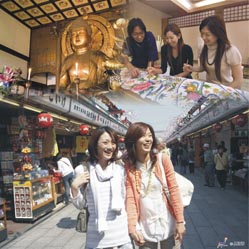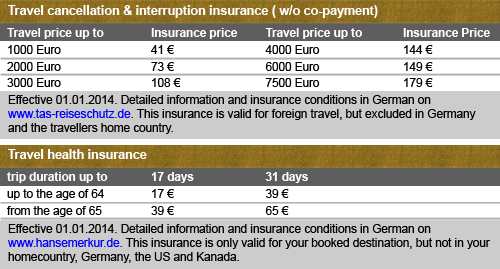In the land of the rising sun
Program
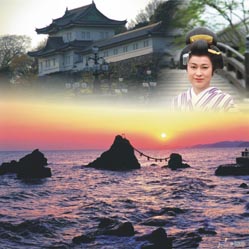
Day 1: Departure from London/Frankfurt
In the evening: Flight from London/Frankfurt via Tokyo to Osaka, where you will arrive the following afternoon (time difference +7h).
Day 2: Welcome to the land of the rising sun
Transfer to the hotel. You will have time for your first explorations in Kyoto, Japan’s most tradition-rich city. The city has a lot of unforgettable attractions to offer. While in spring time it is surrounded by scenting cherry blossoms, the colorful, fluorescent foliage is the dominant sight in autumn.
Day 3: Kyoto - the millennial capital
First you walk along the Emperor’s Palace in Kyoto, which is open to public only 8 days a year. The rockeries as well as the building’s architecture will definitely shape your image of Kyoto. In the so-called Nishijin textile-centre you will be able to enjoy a Kimono fashion show. Combinations of sparkling colours and soft silk will take you to another world. In the Ninna-ji you can then admire the typical architecture of a Buddhist temple and maybe you will have the opportunity to listen to a Buddhist priest singing the sutra. The Golden Pavilion (Kinkakuji) is equally something you will not forget. The construction of this temple, which is known officially as Rokuon-ji began in 1397. It was meant to be part of the seniority residence of Shogun Ashikaga Yoshimitsu. After his death in 1403 Kinkakuji, which was covered completely with beatgold, was transformed to a Zen temple.
Day 4: Gion - Geisha lane
Kyoto probably left a memorable first impression on you already but now we will deepen this impression by showing you more of it.
The Nijo Castle, constructed by Tokugawa Ieyasu, the third unifier of Japan, for power demonstrating purposes, is totally different from the Emperor’s Palace with its simplistic design. Watch the painted walls and the sliding doors and listen to the „nightingale floor“.
Not far from that is located the next highlight, the enormous entrance gate to the Chion-in Temple complex. You wander through the Maruyama Park and Yasaka Shrine towards the Gion neighborhood where there is a long alley with a lot of small businesses which will gladly offer you lots of different delicacies including excellent service.
The temple of clear water
Once you arrived on top you will have a superb view onto the town of Kyoto. You can enjoy this view best from the vast balcony of the Kiyomizudera Temple. The translation of Kiyomizudera is approximately „temple of clear water“. It was founded in 780 AD and was since then associated with the Hosso-sect, one of the oldest Japanese Buddhist sects. Under the famous wooden terrace you can taste the crystal clear spring water that gave the temple its name. It is supposed to have healing effect.
The next stop is at Gion Corner Theatre which brings us closer to Japan’s history and culture. There you will attend an exhibition in the Maiko gallery on different utensils of Geishas in training as well as a presentation of traditional Japanese art such as Ikebana, Kabuki theatre, Bunraku doll theatre and geisha dances.
Day 5: Arashiyama - Zen temple in the bamboo grove
Kyoto is located right in between some forested mountain chains. Today you are going to explore the scenic Arashiyama. As far back as in the 8th century aristocrats came here to enjoy the countryside. Likewise you will stroll through the bamboo groves and visit the Zen-temple Tenryuji, which is part of UNESCO’s World Cultural Heritage. Its landscaped garden from the 14th century is preserved in its original shape. After a walk over the famous Togetsukyo Bridge you will be delighted by the outlook from Iwatayama.
Day 6: Nara - Deer and Buddha
The next excursion of your Japan trip leads you to Nara, Japan’s first capital. The tame Nara deer, symbol of the city, welcome you to their home. There is a highlight right at the beginning of the roundtrip. The Kofukuji hosts the country’s highest, 5-story tall pagoda. After visiting the local National Museum the roundtrip goes on. The next interesting location is the „Big East Temple“(Todaiji-complex). In the biggest wooden building of the world is situated as well the world’s biggest bronze Buddha statue. Enjoy the great achievement of the captivating ancient art of construction and the harmonious atmosphere. Afterwards you can stroll through the row of the 3000 lanterns decorating the Kasuga- Taishi Shrine.
Day 7: The„White Heron“
Today you can walk on the wings of the „White Heron“, the castle complex of Himeji-jo. It was built 1580 Toyotomi Hideyoshi, the second unifier of the Japanese empire. It was considered to be invulnerable. Its white walls gave it the nickname „white heron“. It was a cultural treasure for a long time and was declared World Cultural Heritage by the UNESCO in 1993. Right next to the castle complex there is Koko-en Park, which is composed by nine different gardens. These gardens emulate exactly the shapes of the nine former samurai residences.
Day 8: Osaka - tradition and modern age
Umeda, the central train station of Osaka looks at first sight like a busy anthill where lots of people run around in all different directions. The modern Japan waits at the gates of the station to present itself to the new visitors. After only a minute you stand in front of an impressive department store with integrated Ferris wheel. On the Umeda Skybuilding, one of the most modern buildings of Osaka you get the best overview of the city. At the height of 173 m you have a beautiful, far reaching view on the city of rivers. During a river ride on Yodogawa Osaka’s unique skyline presents itself to you on both sides of the river while young Japanese pursue their favorite hobby, baseball. Also you cannot miss the noble castle of Osaka when visiting Japan’s second biggest city.
Day 9: Kobe - the significant harbour town
The sightseeing walk through Japan’s most important harbour town leads you first to the townhall where you have a magnificent panoramic view and you even can spot the world’s longest suspension bridge. Afterwards you will head to the harbour. Here you see a small gallery which is dedicated to the earthquake of 1995. It lasted only 20 seconds and had a magnitude of 7.2. You will see some square-meters of cracked floor and series of images from the incident that will take your breath away. From there you will quickly get to „Nankinmachi“, Kobe’s Chinatown. This neighbourhood emerged 120 years ago by the time Chinese immigrants opened several restaurants there.
In the afternoon you will get an insight into the manufacturing process of the famous rice wine, the „sake“.
Day 10: Gifu und Nagoya - Japanese traditions right in front of your eyes
You leave Kobe and go on the trip to Nagoya. There the first thing you see will be the town’s landmark, two golden dolphin-like creatures on top of the castle. After an extensive tour through the old military facilities the trip goes on to Gifu at the center of Japan. During the ride with one of the trains you will broaden your first impression and get more and more a feeling for the country. You will drive up to the spectacular Gifu castle with the funicular railway. Afterwards there will be something totally ordinary: drinking tea... But probably a little different from what you are accustomed to. You will get to know the ancient art of „Cha-no-yu“, the tea ceremony, in a public tea house where you should try a cup of green tea and some Japanese sweets. At the end it is planned to visit the Shoboji temple where the biggest gold statue made out of dry varnish is located. The great Buddha has been finished in 1832 after 32 years of construction.
Tonight you have the exceptional opportunity to spend the night in a Ryokan, a traditional Japanese hotel. Do not miss the occasion to take a relaxing bath.
Day 11: A dashing crossing
In the morning you will betake to the train station where you wil hop in the Japanese high-speed train Shinkansen. Enjoy the view during the luxurious ride to Tokyo. After the relaxed journey, the capital of Japan welcomes you. Your hotel is located in Asakusa, one of the liveliest neighbourhoods in Tokyo. Right from the beginning of your stay you will notice that you are in the nation’s capital. Enormous buildings that rise to the sky are typical for the cityscape of Tokyo.
Gigantic lantern at the „Thundergate“
After a 5 minute’s walk you get to the famous thundergate (Kaminari-Mon). Underneath it there is a gigantic red lantern which you will pass and then find yourself on Nakamise. The Nakamise, similar to a market place, is a street with a lot of different shops where you can buy plenty of traditional sweets, dishes and toys as well as fabrics and clothes. The Nakamise leads to Sensoji, better known as Asakusa-Kannon temple, which was founded in the 7th century when two fishermen found a Kannon statue in the river. Even today hundreds of believers visit the temple on a daily basis.
The day continues with a visit of the Edo-Tokyo museum. Even from the outside this museum is a tourist attraction. Also the inside of it is unique with its life-sized sculptures and recreated bridges and buildings. Being on a visit to Tokyo, you cannot miss a stroll across Ginza. It was built by two British architects at the end of the 19th century who took Paris as a design model. Today it is one of the most exclusive shopping miles of whole Tokyo.
Buildings over and over
In the evening you drive to Shinjuku, the business quarter. „The sky is the limit“ is the mantra when you climb up one of the skyscrapers of the Metropolitan Government Building Observatories. You have a magnificent view onto the city from the 45th floor and when the weather is good, you can even see as far as the Fuji-san.
Day 12: Busy goings-on - the fish market und Shibuya
The twelfth day of your Japan trip starts with a visit to the world’s biggest fish market, Tsukiji. On the way to it everything is sold what is needed for the draught, processing and consumption of the fish. Right here you will also get the freshest sushi of all Japan. After a walk in the Hama-Rikyu garden from which you have a beautiful view on the Tokyo Tower, you drive to Harajuku. You pass the crazy and fancy-clothed teenagers to go right away to the famous Meiji Shrine which is the centerpiece of the forested Yoyogi park. The shrine which is dedicated to the emperor’s couple is considered as a classic example of Shinto architecture. During the New Year’s holiday this is one of the most visited places of the country.
For finishing the day we have planned a visit to Shibuya. The memorial in honor of Hachiko resembles a dog that waited for his owner every day at this exact spot, even after his death. It looks upon one of the liveliest crossroads of Tokyo which is crossed by thousands of people at the same time when the traffic light is green.
Day 13: From tradition to the modern age
This morning you will have some free time to discover the Asakusa-neighbourhood on your own. Afterwards you get the rare opportunity (because it is normally closed to the public) to visit the Emperor’s palace. Get an insight on the „Imperial Household Agency“, which organizes the life of the Emperor’s family, and take a closer look at the Chowaden hall, where the Emperor’ family welcomes visitors twice a year. Furthermore there is the controversial Yasuki Shrine where Japanese honor the souls of those who lost their lives for the sake of Japan. In the evening a tour around the streets of the electronic quarter Akihabara that are enlightened by a vast number of neon signs and a visit to the Tokyo Anime center awaits you.
Day 14: Past and future
This morning you will be going on a tour through Ueno Park, Japan’s first inner-city park. In the Shitamachi museum the Tokyo from the beginning of last century rises back to life. In recreated trade and crafts stores you can even try those tools for yourself. There are many different temples situated in the park, for example the Kiyomizu-Kannon temple. This temple which is an imitation of identically-named temple in Kyoto is mostly visited by women hoping for a child. The octagonal Bentendo Temple is located on a scenic island right in the middle of Lake Shinobazu and few steps away from it is the Tokogu Shrine. On its door you will see two golden dragons that seem so real that in common parlance it is claimed that the dragons awake at night and drink out of the lake. After a stroll on the busy marketplace of Ameya-Yokocho you will drive to Ryogoku. At this location are the most sumo training grounds as well as the sumo stadium. Here you are going to step into a boat on the Sumida River and go to Odaiba, the heaped up harbour of Tokyo. Enjoy the view onto the enlightened harbour area and the „Rainbow Bridge“ from the 24th floor of the Fuji headquarters. Finally you can take a walk through Palette Town, an entertainment center that has something to offer for everybody. On the one hand there is the Toyota City Showcase where you face an exhibition of all car models made by Toyota. On the other hand there is Venus Fort, a shopping mile shaped like an Italian town with enlightened sky matching the real one.
Day 15: Kamakura - The city by the sea
19 shrines and 65 temples indicate the past importance of Kamakura, the former Japanese capital. During your stay in the „town by the sea“ you are going to visit the oldest Zen temple of Kamakura, Kencho-ji, as well as Enno-ji which is famous for the ten figurines of the judges of the dead that often scare the visitors.
In the afternoon you will be amazed about Kamakura’s landmark, the great Buddha. You will also visit the temple of Hasedera. This 13,5m tall Buddha statue is standing outdoors because the building that was built for its protection was destroyed so frequently in the past by fire, water and earthquakes that it was finally abandoned. In consequence the trees and the broad sky make a beautiful scenery for this Buddha.
From the terrace of Hasedera Temple there is a magnificent view onto the ocean to enjoy.
Day 16: Japan’s holy mountain
Today you will go to the Fuji-San. With an altitude of 3776m it is Japan’s tallest mountain and it is considered as holy because of its almost perfect symmetry. Just until a hundred years ago only priests and pilgrims were allowed to ascend it. You will take a cable car to scale Mount Fuji and rise atop of Japan’s beautiful countryside. You will arrive at the north side of Lake Ashi where we planned a boat trip or you. Afterwards you will be able to enjoy the view onto the snow-covered summit of Fuji-san from the inactive volcano crater of Komagatake.
Day 17: Nikko - Japan’s sunray
„Do not say beautiful before you saw Nikko“, is an old Japanese saying. After a Buddhist priest founded the temple of Rinnoji 1200 years ago, Nikko evolved quickly into a spiritual and religious center of Buddhism and Shintoism.
In the Futara Shrine remains the „ghost lantern“ that even got the courageous Samurais terrified. The Toshogu Shrine with the mausoleum of the third unifier of the Japanese empire, Tokugawa Ieyasu, was built by his grandchild at the beginning of 17th century as a magnificent building. Especially the painted woodcarvings are interesting to see. The Taiyuin mausoleum was then built for Ieyasus grandchild who wanted to serve his famous grandfather even after his death. In 1999 the UNESCO organization declared the collectivity of the temples and shrines as well as the surroundings of Nikko to be World Cultural Heritage. This nomination does credit to the city of Nikko whose name can be translated as „sunray“.
Day 18: Farewell
Today it is about time to say goodbye to Japan (but only for this time).Take a last look on the busy metropolis out of the plane before you will arrive in your home country in the evening.
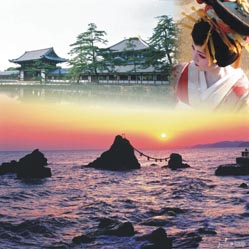
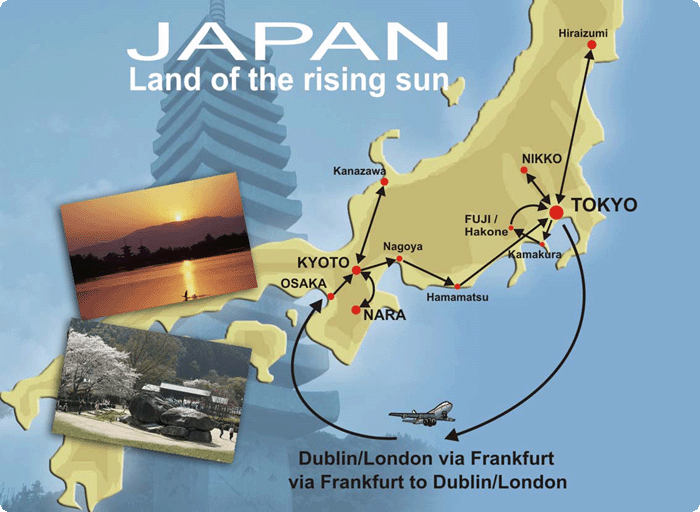
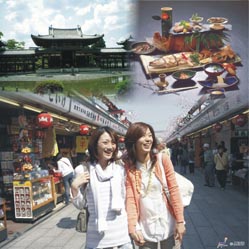 Features
Features
